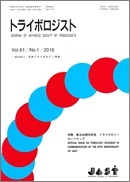62 巻, 8 号
特集・金属材料のトライボロジー
選択された号の論文の14件中1~14を表示しています
- |<
- <
- 1
- >
- >|
会告
-
2017 年 62 巻 8 号 p. K8
発行日: 2017/08/15
公開日: 2017/08/15
PDF形式でダウンロード (1165K)
目次
-
2017 年 62 巻 8 号 p. M8
発行日: 2017/08/15
公開日: 2017/08/15
PDF形式でダウンロード (569K)
連載・トライボロジーを語る
-
2017 年 62 巻 8 号 p. 483
発行日: 2017/08/15
公開日: 2017/08/15
PDF形式でダウンロード (528K)
特集・金属材料のトライボロジー
-
2017 年 62 巻 8 号 p. 484
発行日: 2017/08/15
公開日: 2017/08/15
PDF形式でダウンロード (525K)
解説
-
2017 年 62 巻 8 号 p. 485-489
発行日: 2017/08/15
公開日: 2017/08/15
PDF形式でダウンロード (1134K) -
2017 年 62 巻 8 号 p. 490-494
発行日: 2017/08/15
公開日: 2017/08/15
PDF形式でダウンロード (2163K) -
2017 年 62 巻 8 号 p. 495-500
発行日: 2017/08/15
公開日: 2017/08/15
PDF形式でダウンロード (3152K) -
2017 年 62 巻 8 号 p. 501-508
発行日: 2017/08/15
公開日: 2017/08/15
PDF形式でダウンロード (2716K) -
2017 年 62 巻 8 号 p. 509-514
発行日: 2017/08/15
公開日: 2017/08/15
PDF形式でダウンロード (2186K) -
2017 年 62 巻 8 号 p. 515-521
発行日: 2017/08/15
公開日: 2017/08/15
PDF形式でダウンロード (1611K)
トライボロジー・ナウ・トライボロジー海外体験記 ―アラウンド・ザ・ワールド―
-
2017 年 62 巻 8 号 p. 522-525
発行日: 2017/08/15
公開日: 2017/08/15
PDF形式でダウンロード (2843K)
技術論文
-
2017 年 62 巻 8 号 p. 526-531
発行日: 2017/08/15
公開日: 2017/08/15
[早期公開] 公開日: 2017/06/09PDF形式でダウンロード (1769K)
速報論文
-
2017 年 62 巻 8 号 p. 532-536
発行日: 2017/08/15
公開日: 2017/08/15
[早期公開] 公開日: 2017/06/09PDF形式でダウンロード (1264K)
会のページ
-
2017 年 62 巻 8 号 p. 537-540
発行日: 2017/08/15
公開日: 2017/08/15
PDF形式でダウンロード (1111K)
- |<
- <
- 1
- >
- >|
